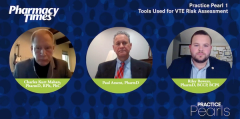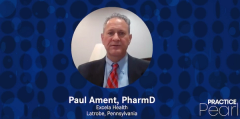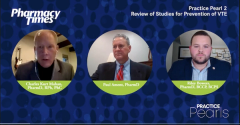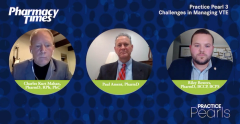
Practice Pearl 2: Review of the Direct Oral Anticoagulants for VTE
Episodes in this series

Riley Bowers, PharmD, reviews the direct oral anticoagulants [DOACs] indicated for VTE treatment.
Charles Kurt Mahan, PharmD, RPh, PhC: Let’s discuss the direct oral anticoagulants [DOACs] that are indicated for VTE [venous thromboembolism] treatment. You could touch on some of the efficacy and safety issues and special problems, such as if patients are overweight, obese, or have renal issues and are on dialysis. If we can touch on some of those, please.
Riley Bowers, PharmD, BCCP, BCPS: I’m going to start at those that are less easy to use in the VTE treatments: dabigatran and edoxaban. The only reason I’m lumping these together is because they both require 5 days of parenteral anticoagulation before being initiated for the treatment of DVT [deep vein thrombosis] and PE [pulmonary embolus]. In their respective landmark trials, the RECOVER I and RE-COVER II trials for dabigatran and edoxaban with the Hokusai VTE trial, both the agents showed noninferiority as far as efficacy when you’re talking about VTE recurrence and VTE-related mortality compared with the warfarin plus the low molecular weight heparin.
It is important to note that edoxaban had significantly lower bleeds. Dabigatran initially demonstrated similar bleeding rates to warfarin, but when you’re looking at dabigatran compared with other DOACs, you have to start worrying about increasing in GI [gastrointestinal] bleeds and bleed risks for patients who are greater than 75 years old. To be perfectly honest, I don’t see a lot of these agents anymore. I never really saw edoxaban frequently, and dabigatran has really fallen off. It’s the oldest DOAC.
As apixaban and rivaroxaban might make things a bit easier across the board in general, you’re seeing less dabigatran used in practice. It could also be because of the required duration of parenteral anticoagulation with those 2 agents. To go into rivaroxaban and apixaban, these are 2 much more commonly used DOACs, especially in the VTE realm because of the simplicity. You can load up with these oral agents, discharge your less severe patient straight out of the emergency department with their prescription, and have them treated orally from day 1.
Rivaroxaban from the EINSTEIN studies, EINSTEIN DVT and EINSTEIN PE, was found to be noninferior when compared with the warfarin—low molecular weight heparin combination in VTE recurrence and mortality. It showed similar rates of bleeding compared with that combination. Then you have apixaban, which was studied in the AMPLIFY trial, and it was once again noninferior compared with warfarin. Nothing has shown more efficacy than that warfarin–low molecular weight heparin combination, but the apixaban did show significantly less major bleeding. Those are all important tools and important things to keep in mind when you’re making that decision on what oral agent to start initially or to switch to in your DVT and PE patients
Newsletter
Stay informed on drug updates, treatment guidelines, and pharmacy practice trends—subscribe to Pharmacy Times for weekly clinical insights.


























































































































































































































